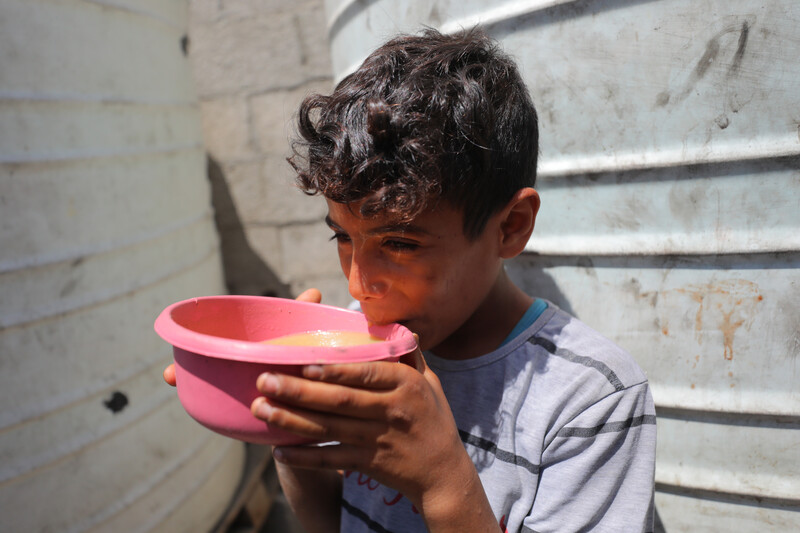Rights and Accountability 2 May 2025

Gaza’s health ministry warns that at least 60,000 children are now showing symptoms of malnutrition. (Omar Ashtawy / APA Images)
The following is from the news roundup during the 1 May livestream. Watch the entire episode here.
It has been more than 60 days of a complete siege on the Gaza Strip when, on 2 March, Israel closed the crossings and blocked the entry of food, fuel, medicine, medical equipment and other essentials.
Bombings and airstrikes have continued nonstop, killing dozens of Palestinians every day.
Since Israel broke the so-called ceasefire and resumed its relentless massacres on 18 March, more than 2,300 Palestinians have been killed and nearly 6,000 have been injured, according to the Palestinian health ministry in Gaza.
The official death toll since October 2023 is 52,000, the ministry reports, with thousands more still buried and unaccounted for under the rubble.
Al Jazeera’s Hani Mahmoud reported that on Wednesday, 30 April, massive explosions rocked the central and northern parts of the Gaza Strip. In Nuseirat refugee camp in central Gaza, three separate overnight attacks hit residential buildings with people inside.
“Those who survived the attack described it as an earthquake that shattered the entire building,” Mahmoud said.
“In one building, eight were killed in a single attack. Emergency workers are still looking for more. The number of people killed is expected to rise as more family members are still looking for their loved ones.”
Israeli attacks have intensified across northern Gaza, and in al-Mawasi and other areas southwest of Khan Younis, where displaced Palestinian families have sheltered in makeshift encampments and buildings.
The United Nations human rights office stated that between 18 March and 27 April, there were 259 Israeli attacks on residential buildings and 99 on the tents of displaced people.
“Most of the attacks resulted in fatalities, including of women and children,” the UN said. Among the strikes on tents, “40 reportedly took place in al-Mawasi … where the Israeli army repeatedly directed civilians to seek refuge.”
On Monday, 28 April, an Israeli drone attack killed nine people, including five children in Gaza City.
Dr. Munir al-Bursh, the director of the health ministry in Gaza, said that a pregnant woman was shot in the head by an Israeli drone the same day.
He stated that medical teams at Al-Shifa Hospital in Gaza City were able to surgically deliver the baby, but the mother remained in a critical condition.
On 24 April, Palestinian journalists captured a video of a small child, later identified as 6-year-old Ali Faraj, who survived the bombing of his family’s home in Gaza City.Due to the high impact of the bomb, Ali was thrown onto a neighboring roof, as was his father and one of his sisters.
Ali called out for help beside the dead bodies of his father and sister. His 5-year-old sister, who was wearing a pink dress, was torn in half.
The Anadolu news agency reported that Ali’s mother was frantically searching for him beneath the rubble of their destroyed house and did not know that he had landed on the roof of the house next door.
Her husband and their daughters, Zeina, Leen, Razan, Suaad and Jouri, aged between 2 and 14, were all killed in the attack.A reporter from the news agency visited Ali Faraj at the Kuwait Specialist Hospital in Gaza, where he was receiving treatment for a severe abdominal injury.
“The walls collapsed, and I fell. I don’t know what happened. I was with my dad … then there was a huge explosion,” the boy said.
Food could run out “within days”
Palestinians in Gaza endured yet another week of Israel’s engineered starvation policy and the total collapse of infrastructure, as more than 90 percent of people across the Strip remain forcibly displaced.
Sandstorms blew in on 30 April, compounding an already dire situation for displaced Palestinians.
The World Food Programme stated on 27 April that all of its food stocks are depleted, forcing the closure of all of its supported bakeries and cutting off access to bread for 800,000 people.“Food parcels are fully exhausted, and the last remaining supplies have been delivered to hot meal kitchens, which are expected to run out within days,” the WFP stated.
The United Nations says that its partners, including the World Food Programme, “have pre-positioned over 171,000 metric tons of food in the region, ready for delivery as soon as restrictions on the entry of supplies, imposed by the Israeli authorities since 2 March, are lifted. This amount is enough to sustain the entire population of about 2.1 million people for three to four months.”
“People’s coping strategies have been stretched to the limit,” the UN adds. “Widespread displacement has forced many people to abandon food supplies and emergency stocks secured during the ceasefire.”
Amjad Shawa, the director of the Palestinian Non-Governmental Organizations Network in Gaza, told Reuters news agency that of the 70-80 community kitchens still working in Gaza, in just a matter of days they could be forced to close.
Fifteen have already closed earlier this week, he said.
The Gaza health ministry said at least 60,000 children are now showing symptoms of malnutrition.
Juliette Touma, the spokesperson for the UN agency for Palestine refugees, said this week that “the siege on Gaza is the silent killer of children, of older people. Families – whole families, seven or eight people – are resorting to sharing one can of beans or peas.”
“Imagine not having anything to feed your children. Children in Gaza are going to bed starving,” Touma warned.
In addition to the food, medicine and water catastrophe, the fuel situation is quickly deteriorating.
The United Nations stated this week that “with accessible benzene nearly depleted and diesel reserves critically low, remaining fuel is being prioritized for health, water, sanitation and telecommunications services to sustain life-saving operations.”
“Humanitarian partners have made repeated attempts to retrieve fuel from areas that are currently inaccessible – either because they are under active displacement orders or located in ‘no-go’ zones that require humanitarians to coordinate with Israeli authorities,” the UN humanitarian office stated.
“However, efforts to access these areas are routinely denied.”
The Gaza Civil Defense Corps warned on 28 April that because of the lack of fuel, eight out of its 12 rescue vehicles, including firefighting and ambulance trucks, are unable to operate.
The Gaza municipality this week reported that they have been forced to dump waste in the middle of Gaza City because Israeli forces have prevented sanitation crews from reaching the main dump east of the city for 18 months.
Some 260,000 tons of waste have accumulated in landfills and on city streets, creating a health and environmental disaster, the municipality said.Paramedic released from Israeli detention
Ten Palestinian detainees were released from Israeli jails this week and returned to Gaza. Al Jazeera’s Tareq Abu Azzoum reported on 29 April that the detainees were in desperate physical and psychological conditions.
Among the released detainees was Assad al-Nassasra, the sole survivor of the Israeli military ambush and attack on a group of paramedics and ambulance drivers in late March.
As we reported, 14 rescue workers and one UN worker were summarily executed by Israeli soldiers, and their bodies were dumped into a mass pit. The ambulances were also buried in the dirt.Al-Nassasra spent 37 days in Israeli detention and has yet to speak publicly about his experience witnessing and surviving the massacre.
Israeli soldiers shoot, kill Palestinian child near Nablus
Turning to the occupied West Bank, Israeli forces shot and killed a 16-year-old Palestinian boy in the northern town of Salem on 25 April.
According to Defense for Children International-Palestine, Abdulkhaleq Mosab Jabour was shot in the chest by Israeli soldiers while he was closing up the shop where he worked while Israeli forces began carrying out a military incursion at about 3:30 pm.
“Israeli forces are relentlessly targeting Palestinian children from Nablus to Jerusalem to Gaza without a moment of reprieve,” said Ayed Abu Eqtaish, accountability program director at DCIP.
“Abdulkhaleq was clearly no threat to Israeli soldiers, and yet they fatally shot him anyway, and as usual, no one will be held accountable for killing a Palestinian child in cold blood. How many Palestinian children’s bodies is enough for the world to enact sanctions on Israel and force accountability?”
Israeli forces have killed 24 Palestinian children in the occupied West Bank in 2025, the children’s rights group stated.
Activist and journalist Basel Adra filmed footage of Israeli bulldozers destroying homes and water wells in Masafer Yatta, near Hebron in the southern West Bank.
Local news sources say that these demolitions are part of a series of intensifying attacks by the Israeli army and their settler foot-soldiers on the villages in Masafer Yatta.Settlers have routinely vandalized and destroyed homes and farmland in the area, and are working to expand illegal colonial outposts.
Meanwhile, Israeli settlers set fire to Palestinian agricultural land and stabbed a Palestinian man in the town of Duma, near Nablus, on 30 April.
The attack came as huge fires rapidly spread across the Jerusalem Hills, reaching Israeli occupation forces’ bases and prompting Israel to request international assistance, Wafa news agency reported.
In Jenin, Israeli forces raided and ransacked the family home of veteran journalist Ali Samoudi on 29 April at 5 am, then interrogated and detained him.
The Israeli army said that because of a deterioration in his health, Samoudi was being transferred to a hospital.
Samoudi’s family said that Israeli authorities had not told them the name of the hospital where he was being treated or any other details, but that he is expected to be brought before a military court next week.
Samoudi, who has reported from Jenin for decades and contributed to local and international outlets, was working alongside Al Jazeera correspondent Shireen Abu Akleh when she was assassinated by an Israeli sniper nearly three years ago.
He was also shot in the shoulder during that attack on journalists.
Highlighting resilience
Finally, as we always do, we wanted to highlight people expressing joy, determination and resilience across Palestine.
Musician and music teacher Ahmed Muin regularly films himself and his students singing, playing music and trying to alleviate the trauma through his project, Gaza Birds Singing.
On Wednesday, he posted this video with the caption”A child’s smile is stronger than war.”






Comments
speak
Permalink Carol Scheller replied on
This thorough picture of the overall grim situation at present deserves top coverage in all major newspapers in the US. Hope and resiliance are always there, and Ms Barrows-Friedman has the knack of finding them. Am I the only one to notice how Al Jazeera journalists Hani Mahmoud and Tarek Abu Azzoum have lost a considerable amount of weight ?
Add new comment